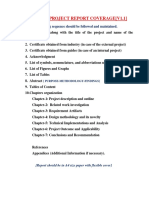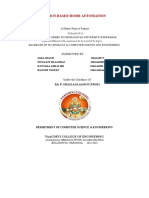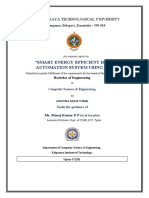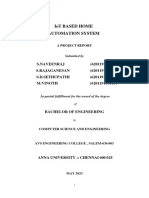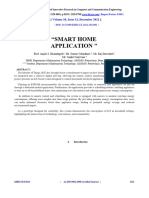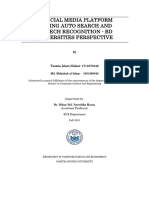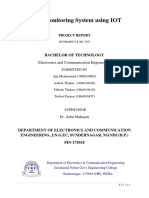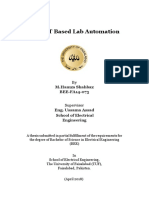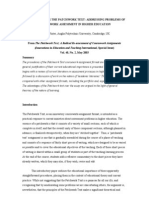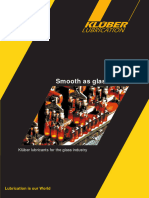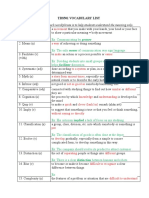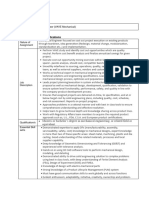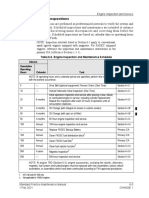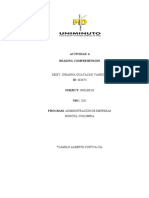ENERGY OPTIMIZATION THROUGH BEHAVIOR
BASED AUTOMATED CONTROL
A PROJECT REPORT
Submitted by
ABINAYA B 420421104003
NIVETHA A 420421104047
SIVARANJANI R 420421104074
in partial fulfillment for the award of the degree
of
BACHELOR OF ENGINEERING
in
COMPUTER SCIENCE AND ENGINEERING
ADHIPARASAKTHI ENGINEERING COLLEGE
MELMARUVATHUR
ANNA UNIVERSITY :: CHENNAI 600 025
MAY 2025
i
� ANNA UNIVERSITY : CHENNAI 600 025
BONAFIDE CERTIFICATE
Certified that this project report titled “ENERGY OPTIMIZATION THROUGH
BEHAVIOR BASED AUTOMATED CONTROL” is the bona fide work of
ABINAYA B (420421104003), NIVETHA A (420421104047), SIVARANJANI R
(420421104074) who carried out the work under my vision.
SIGNATURE SIGNATURE
Dr. C. DHAYA, Ph.D., Ms. A. JAYANTHI, M.E.,
HEAD OF THE DEPARTMENT, SUPERVISOR,
Professor, Assistant Professor,
Department of CSE, Department of CSE,
Adhiparasakthi Engineering College, Adhiparasakthi Engineering College,
Melmaruvathur - 603 319. Melmaruvathur - 603 319.
Submitted for the CS8811 Project work / Internship and Viva-voce examination
held on …………at Adhiparasakthi Engineering College, Melmaruvathur.
INTERNAL EXAMINER EXTERNAL EXAMINER
ii
� ACKNOWLEDGEMENT
With the divine blessings of Goddess Adhiparasakthi, we express our
deep gratitude for the spiritual blessings of His holiness PADMA SHRI
ARULTHIRU AMMA and the divine guidance of THIRUMATHI AMMA that
has undoubtedly taken us to path of victory in completing this project.
The infrastructural support with all kinds of lab facilities have been a
motivating factor in this completion of project work, all because of our
Correspondent Sakthi Thiru Dr. G. B. SENTHILKUMAR B.E. with great
pleasure we take this opportunity to thank him.
For the academic side the constant support from our honorable Principal
Dr. J. RAJA, Ph.D., as encourages us to work hard and attain this goal of completing
the project.
Our sincere thanks to our Head of the Department Dr. C. DHAYA,
Ph.D., who has given us both moral and technical support adding experience to the
job we have undertaken.
We thank our Project Coordinator Mr. K. CHAIRMADURAI, M.E.,
and Ms. S. SUBASHINI, M.E., who has led from the front questioning us at the
right time and encouraging us most of the time here by extracting quality work
from us.
We sincerely thank our Supervisor, Ms. A. JAYANTHI, M.E., who
helped us in crossing the path to our glory. We also thank other staff members,
librarian, and non-teaching staff members for their support and motivation in all our
endeavor.
iii
� ABSTRACT
The world of intelligent devices for smart home automation has expanded
rapidly in recent years. The modern lifestyle of today demands smart systems at all
times and locations to make life better and easier. The growing use of smart home
technology has revolutionized modern living by offering energy efficiency,
convenience, and security. This paper explores the enhancement of smart home
automation using behavior-based automation.
We propose a system that collects data on a user’s daily home entry times
over a period and uses this data to adjust the indoor environment, such as pre-
conditioning the air conditioning (AC) based on anticipated home arrival times. In
cases where the user deviates from their usual schedule, anomaly detection
algorithms are employed to identify discrepancies in entry times and adjust the AC
settings accordingly, including turning off the system to conserve energy if the user
is late.
By analyzing past behavior the system intelligently optimizes alternating
current consumption, reducing unnecessary power consumption. It mainly focuses
on understanding the user's behavior and adapting .The effectiveness of this system
is evaluated through simulations and real-world data, demonstrating its potential for
reducing energy consumption.
iv
� TABLE OF CONTENTS
CHAPTER TITLE PAGE NO
NO
ACKNOWLEDGEMENT ii
ABSTRACT iv
LIST OF SYMBOLS v
LIST OF FIGURES ix
LIST OF ABBREVIATION xi
1 INTRODUCTION 1
1.1 DOMAIN OVERVIEW 1
1.2 OVERVIEW OF THE PROJECT 1
1.3 OBJECTIVE OF THE PROJECT 2
1.4 MOTIVATION 2
2 LITERATURE SURVEY 3
3 SYSTEM ANALYSIS 7
3.1 EXISTING SYSTEM 7
3.1.1 DISADVANTAGES 8
3.2 PROPOSED SYSTEM 8
3.2.1 ADVANTAGES 8
3.3 ALGORITHMS 9
3.3.1 ANOMALY DETECTION 9
4 SYSTEM SPECIFICATION 11
4.1 FUNCTIONAL REQUIREMENTS 11
4.2 NON-FUNCTIONAL REQUIREMENTS 11
4.3 HARDWARE REQUIREMENTS 12
v
� 4.4 SOFTWARE REQUIREMENTS 13
4.5 FEASIBILITY STUDY 14
4.5.1 ECONOMICAL FEASIBILITY 14
4.5.2 TECHNICAL FEASIBILITY 15
4.5.3 SOCIAL FEASIBILTY 15
4.5.4 OPERATIONAL FEASIBILITY 15
5 SYSTEM DESIGN AND DEVELOPMENT 16
5.1 INTRODUCTION 16
5.2 FILE DESIGN 16
5.3 INPUT DESIGN 16
5.4 OUTPUT DESIGN 17
5.5 SYSTEM ARCHITECTURE 17
5.6 USE CASE DIAGRAM 19
5.7 DATA FLOW DIAGRAM 20
5.8 CLASS DIAGRAM 21
6 TECHNOLOGIES 22
6.1 PYTHON LANGUAGE 22
6.2 CHARACTERISTICS 22
6.3 INTERNT OF THINGS 23
6.3.1 BENEFITS OF IOT 23
6.3.2 KEY TECHNOLOGIES IN IOT 23
6.3.3 APPLICATIONS OF IOT 24
6.4 ANOMALY DETECTION ALGORITHM 24
6.4.1 BENEFITS 24
vi
�7 TEST CASES 25
7.1 TESTING TECHNOLOGY 25
8 MODULES 27
8.1 MODULE DESCRIPTION 27
8.1.1 DATA COLLECTION 27
8.1.2 DATA PREPROCESSING 27
8.1.3 BEHAVIOUR PATTERN ANALYSIS 27
8.1.4 ABNORMALITY DETECTION 28
8.1.5 CONTROL AND AUTOMATION 28
8.1.6 FEEDBACK AND LEARNING 28
8.1.7 EVALUATION AND SIMULATION 28
9 CODING 29
10 SCREENSHOTS 34
11 CONCLUSION 35
REFERENCES 36
vii
� LIST OF SYMBOLS
SYMBOL NAME NOTATION DESCRIPTION
Class name
Class represents a
Visibility attribute
collection of similar entities
Class Type=initial value
grouped together
Visibility operation
(arglist):return type
Association represents a
static relationship between
Association
classes.
A use case is an interaction
between the system and
Use case
other external examination.
It is used for Additional
Relational
Process Communication
It represents the control
Control flow
flow between the state
A circle in DFD represent
the vertical dimension of the
Data process/State
object communication
viii
� An object lifeline
Object lifeline represents the vertical
dimension then object
Communication.
It represents the
Message Message
exchanged
Actors are the user of the
system and other external
Actor entity that react with the
system
ix
� LIST OF FIGURES
FIGURE NO TITLE PAGE NO
3.1 Existing System vs Proposed System 9
4.3.1 Arduino Nano 12
4.3.2 Relay Module 13
4.3.3 Jumper Wire 13
5.1 System Architecture 18
5.2 Use Case 20
5.3 Data Flow 21
5.4 Class Diagram 22
10.1 Terminal Output of Intelligent AC 35
Automation Based on User Inputs
10.2 Hardware Response to Occupancy and 35
Time-Based AC Control
x
� LIST OF ABBREVIATIONS
SYMBOL ABBREVIATION
AI Artificial Intelligence
IOT Internet of Things
ML Machine Learning
LED Light Emitting Diode
IR Infrared
PIR Passive Infrared Sensor
AC Air Conditioner
DC Direct Current
USB Universal Serial Bus
CPU Central Processing Unit
IP Internet Protocol
IDE Integrated Development Environment
GUI Graphical User Interface
ESP Espressif Systems
API Application Programming Interface
xi
�12

